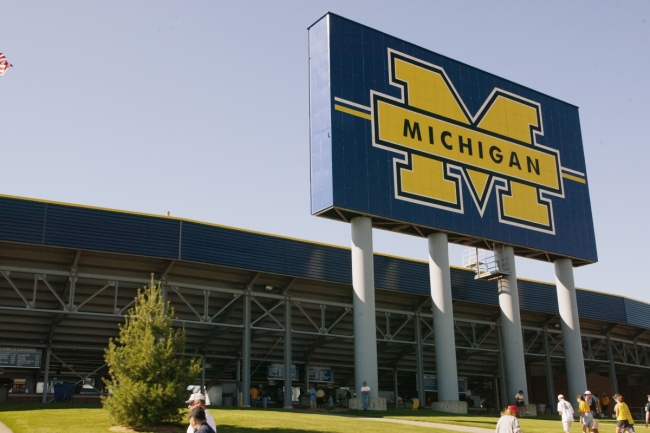You have /5 articles left.
Sign up for a free account or log in.

As part of a settlement, the university will create and fund a Coordinated Community Response Team.
Danny Moloshok/Getty Images
The University of Michigan has agreed to settle a lawsuit brought last May by students claiming that university officials failed to stop repeated sexual abuse by former university doctor Robert Anderson, the university announced Thursday. As part of the settlement, the university will create and fund a multidisciplinary standing committee known as a Coordinated Community Response Team (CCRT), a commonly used tool in preventing sexual misconduct on college campuses.
The nonmonetary settlement is pending approval by U.S. District Court Judge Victoria Roberts.
In January, the university reached a $490 million settlement with more than 1,000 people who said Anderson, in his role as head of the health service and then team physician, molested them over a period of 37 years, until he retired in 2003. He died in 2008.
Josephine Graham, now a senior at the university, filed the latest class action lawsuit on behalf of other survivors. She accused university officials of violating Title IX, the law that prohibits sex discrimination at federally funded institutions, in failing to act on persistent complaints of sexual assault against Anderson. The lawsuit states the university “continues to lack appropriate and sufficient policies and procedures to prevent sexual violence on campus, and fails to adequately enforce those policies and procedures.”
Among other things, Graham’s suit sought background checks for all new hires and annual verification of the credentials of all medical personnel. While the settlement doesn’t necessarily go that far, in establishing the CCRT, it promises much closer oversight of sexual misconduct claims.
“This agreement will modernize UofM’s approach to preventing and responding to sexual violence, and ensure our safety is a top priority,” Graham said in a statement. “The CCRT will allow greater input from those in our community, including students like myself, who can help create a better future at our university.”
The CCRT will be made up of about 30 members and co-chaired by an external adviser, Rebecca Veidlinger, an attorney in private practice specializing in Title IX; Sandra Levitsky, an associate professor of sociology at Michigan; and Tamiko Strickman, executive director of the university’s Equity, Civil Rights and Title IX Office and special adviser to the president.
Other members will include Title IX and campus sexual misconduct experts, representatives of the Washtenaw County Prosecutor’s Office, representatives from SafeHouse Center—a local nonprofit organization dedicated to ending domestic violence and sexual assault—students, survivors, community members and select members of the administration and faculty from all three University of Michigan campuses.
“The creation of the Coordinated Community Response Team is another important step toward our vision of becoming a national leader in protecting our community from inappropriate behavior and sexual misconduct,” interim University of Michigan president Mary Sue Coleman said in a statement. “The structure of the team, which includes leadership from outside the university, will give a voice to all members of our community who have a perspective to share on this vital effort.”
This CCRT will be required to meet at least three times per year. It will collaborate with officials and advise the university on a wide range of approaches to preventing and addressing sexual misconduct. Additional details of the CCRT’s formation will be shared following approval by the court.
CCRT is considered “a best practice for colleges and universities that seek to enact serious reforms” around sexual misconduct, the university statement said. Other institutions, including the University of California, Berkeley, and the University of Mary Washington, have similar teams on campus.
Graham’s lawsuit came in response to two recent investigative reports, conducted by a law firm and published by the university, detailing decades of sexual assault on campus. In 2020, the university released a report on Martin Philbert, a former provost who had inappropriate sexual relationships with employees and graduate students, and in 2021, the university released its report on Anderson.
The litany of sexual misconduct didn’t stop there: in January, Michigan’s Board of Regents fired the president, Dr. Mark Schlissel, after he was found using university resources to conduct an affair with a subordinate.
Jordan Acker, chair of the board, said in statement that the creation of the CCRT will give the university another way to support survivors of sexual abuse.
“This commitment to keep listening is a university commitment that will extend to our next president,” Acker said in a statement. “Ongoing community input will help shape the policies and practices of the future.”
Kenyora Parham, executive director of End Rape on Campus, called the settlement a good first step, noting that CCRTs were first used by police, local courts and women’s shelters to address and prevent domestic violence situations.
“I believe what we’re seeing now is universities taking a similar approach to this, really taking that community-based approach and not just talking about what’s on their campus but also integrating external organizations as well as students to address campus sexual assault,” Parham said. “That is the important first step to changing campus culture and ultimately keeping students safe.”
She still has questions about how Michigan’s CCRT will be integrated into the campus community and whether the group will be proactive in preventing sexual assault.
“What is the coordinated community response effort with regard to a prevention strategy?” Parham said. “We can’t just have this team come together, get 30 members and then expect those 30 members are going to change campus culture.”
But she said it’s a positive sign that Michigan agreed to create a CCRT that gives students a seat at the table.
“You can’t create such a program without them,” she said. “They are the ones who are disproportionately affected by this issue, and the university has to take into consideration the narrative perspectives, not only of those who are campus administrators, but also the students and their experiences and their identities.”




